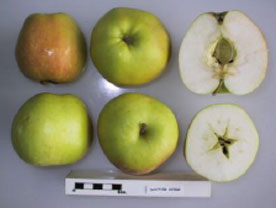History of the Doctor Hogg apple
The Doctor Hogg apple was grown by Head Gardener Mr S. Ford of Leonardslee, near Horsham and thought to be a seedling from the variety Calville Blanc. It was introduced about 1880 by W. Paul & Son, Herts and awarded an RHS First Class Certificate in 1878.
It is currently cultivated as part of Brighton Permaculture Trust’s National Collection in Stanmer Park, Brighton. You can see a Doctor Hogg apple tree (planted 2011) in Home Farm Orchard, Stanmer Park ( map).
Description of fruit
A very large apple, conic and ribbed on body of the fruit. The skin is yellow, flushed pale red with slight stripes and russet patches. White flesh, sweet with slight acidity.
It was named in honour of the Victorian pomologist Robert Hogg, who wrote in his guide to the fruits and fruit trees of Britain:
“….It melts perfectly, does not fall at all, is juicy, slightly acid, very rich and sugary with a pleasant aroma. It is a first rate baking apple.” (Hogg 1851)
Season of use
The fruit can be picked in early September and stored until October.
Tree habit
Doctor Hogg is a vigorous, upright growing tree.
Flowering and pollination
Flowering day: F9
How to identify a Doctor Hogg apple
Apples can be identified by sending them to the National Fruit Collection at Brogdale or by bringing a sample to Apple Day Brighton, where an expert pomologist will be on hand to identify apples. From each tree, bring three or more ripe fruits and a shoot with representative leaves.
Where to buy a Doctor Hogg apple tree
Please contact us for details of our supplier for Sussex apple varieties.
